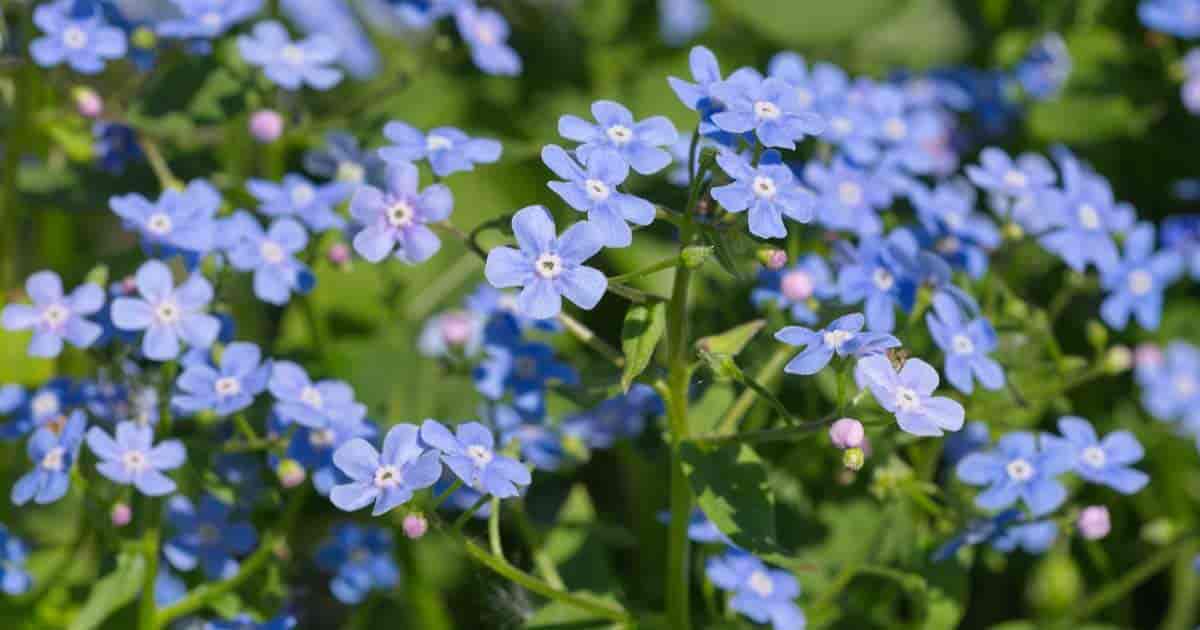Brunnera macrophylla [bruh-NEER-uh mack-roe-FILL-uh] is a herbaceous flowering perennial plant species from the Boraginaceae family and native to the Caucasus.
This plant is a classic perennial, a favorite for many because of its lovely bloom and partial shade tolerance.
This plant makes a stunning groundcover, and also looks great in containers.

The common names for Brunnera macrophylla include:
- Heartleaf Brunnera
- False Forget-Me-Not – more on the True Forget-Me-Not (Myosotis)
- Siberian Forget-Me-Not
- Siberian Bugloss
- Large Leaf Brunnera
Brunnera Macrophylla Plants Care
Size & Growth Rate
Siberian Bugloss is an herbaceous, rhizomatous, hardy perennial, which grows 12” – 18 inches tall.
It forms clumps of large heart-shaped leaves, about 6” inches long with cream or white markings.
The first leaves produced by this plant are oblong-shaped, but gradually heart-shaped leaves form.
These leaves are often deep green color, or spotted or variegated with white tones.
Flowering and Fragrance
During the spring season bloom time, Brunnera macrophylla produces an abundance of tiny blue flowers, which bloom for at least four weeks.
These flowers have five petals and look delicate sprayed all over the foliage.
The colors of these flowers may range from electric blue to pastel, with a yellow colored center.
Light & Temperature
This plant type grows properly in part shade to full shade.
However, it grows under the full sun as well, provided it gets plenty of moisture.
It prefers cool summers but doesn’t do well in humid summer and hot conditions.
The foliage starts to scorch under the prolonged hot sun.
In the north, morning sun is acceptable as long as the soil remains moist.
The growing temperature for this plant is 65° degrees Fahrenheit (18° C), and it performs well in holding temperatures between 50° – 60° degrees Fahrenheit (10° – 15° C).
USDA zone – hardiness zones 3- 8.
Watering and Feeding
The new Large Leaf Brunnera plant likes to be watered well.
For its water needs, it prefers continuous moisture but becomes drought-tolerant when it is properly established.
Mulching is the right way of maintaining the soil of this plant moist and fresh.
While it likes fertile soil, it doesn’t need supplement feeding, provided the soil isn’t too dry or poor.
Soil & Transplanting
Brunnera macrophylla grows well in medium moist soil, well-drained and placed in shady areas.
Keep a consistently moist & rich soil.
This plant doesn’t tolerate dry soils, but it is able to tolerate somewhat dry soil.
This plant is not fussy about the soil pH level.
It requires plenty of organic mulch or organic matter to establish and grow well quickly.
Grooming and Maintenance
This plant performs well in containers and makes for functional filler all through the season.
It is also sufficiently hardy to grow well in the container during the winter season with added protection and care.
The leaves might begin to look tattered as they grow old, and must be cut back in the growing season to encourage new growth.
Avoid cutting the entire plant to the ground during the fall season.
The crown of this plant must be protected by the leaves in the winter so prune during the late spring.
To avoid having this plant self-seed, it is best to deadhead once the flowers start fading.
To collect seeds for sowing, ensure the flowers become slightly dry.
Cut them and dry them up in a paper bag.
The seeds start falling off as the flowers begin to dry.
Ensure the soil of this plant stays moist, but make sure it does not get soggy.
The division should be done during the spring season and is only required every six years.
Other Boraginaceae Family Plant Relatives include:
How to Propagate Siberian Bugloss
The propagation of this plant is done using seeds.
Prepare the seeds during the fall season to ensure the plant blooms the first season.
If the plant is growing under suitable conditions, it will self-seed.
While this plant grows the best through seed, the propagation is also done through separation and division.
It is ideal for propagating cultivars through division as they don’t perform very well with seeds.
It is best to plant the seeds during the summers, and transplant the plant during the fall season.
Divide the plant during early spring.
The root cuttings should be 3” – 4” inches long, taken when the plant is in a dormant state.
Root the cuttings in containers over winter.
Siberian Bugloss Pest or Diseases
This plant doesn’t face any critical disease or pest problems. It is resistant to deer but might get occasional visits from snails and slugs.
Aphids might also be a problem. Keep on the lookout for aphids near new growth and underneath the leaves.
Once detected, it is essential to control the problem immediately in order to avoid damage.
Details on Controlling:
Brunnera Macrophylla Uses
Use this plant near ponds, in woodland plant settings, shade gardens, naturalized areas, borders, or as a ground cover.
It also looks fabulous growing in containers.
This plant works well with plants with different leaf shapes and textures, including daffodils, geraniums, Bleeding Hearts, hostas, iris, and hellebores.